Looking for a heavy hitting big bore cartridge to use in your lever action rifle? Here’s what you need to know about the .450 Marlin.
Most hunters in North American are probably familiar with the .45-70 Government. However, the much newer .450 Marlin cartridge is not nearly as well known.
A favorite among lever-action enthusiasts, the .45-70 Government delivers hard hitting performance, but hunters and shooters must exercise great care to realize the full potential of the cartridge. For this reason, designers at Marlin and Hornady elected to build a brand new cartridge in the .450 Marlin in order to enable hunters to enjoy performance comparable to magnum .45-70 Government ammo in standard factory loads safe to use in all firearms chambered for the cartridge.
In this article, I’m going to discuss the history as well as the strengths and weaknesses of the .450 Marlin in detail. I’ll also provide some information on how the .450 Marlin compares to the .45-70 Government so you can decide which one best fits your needs as a hunter.
Before we get started, I have an administrative note:
Some of the links below are affiliate links. This means I will earn a small commission (at no extra cost to you) if you make a purchase. This helps support the blog and allows me to continue to create free content that’s useful to hunters like yourself. Thanks for your support.
450 Marlin History
First released all the way back in the 1870s, the .45-70 Government cartridge initially used black powder as a propellent. The original black powder load for the cartridge fired a .45 caliber, 405 grain bullet at about 1,350 feet per second.
The cartridge delivered many decades of good service for the U.S. Army as well as for civilian hunters and shooters. Interestingly, the .45-70 Govt enjoyed a big resurgence in popularity during the 20th Century and the use of modern smokeless propellants dramatically improved the ballistics of that cartridge.
While newer rifles like the Winchester 1886, Marlin 1895, and Ruger No. 1 are strong enough to handle more powerful .45-70 loadings, that is not the case with the thousands of older Model 1873 “Trapdoor” Springfield rifles still in use with hunters and shooters.
Designed to fire the original .45-70 black powder load, those Trapdoor Springfields have a relatively weak action by modern standards. For that reason, most .45-70 Government factory ammo is intentionally loaded to lower pressures for safe use in older rifles.
Most reloading manuals also have multiple sections of .45-70 Government loads tailored to specific rifles, with more conservative loadings for use in the Trapdoor Springfield along with some hotter loads intended for use in newer rifles with stronger actions. Some of the big ammunition manufacturers also produce several different lines of magnum .45-70 Govt ammo for use in newer rifles.
All of those developments have created a situation where there are thousands of older rifles with weaker actions in common use in the United States along with lots of handloading recipes and factory ammo choices that are not safe to use in those rifles.
Not surprisingly, despite many emphatic warnings printed in reloading manuals and on boxes of ammo, countless shooters have unintentionally destroyed untold numbers of Trapdoor Springfield rifles through the use of high pressure handloads or magnum .45-70 factory loads.
With all of this in mind, designers at Hornady and Marlin built a new cartridge offering performance on par with the hottest .45-70 Government loads while completely eliminating the risk of accidental use in rifles lacking a strong enough action to safely handle that increased pressure.
Released in 2000, the new .450 Marlin cartridge largely accomplished those goals.
Similar in appearance to the wildcat .458×2″ American cartridge, the .450 Marlin has a belted case to prevent chambering in a .45-70 Government rifle. At the same time, the .450 Marlin has a longer belt than the .458×2″ or the .458 Win Mag (and similar cartridges) that precludes chambering in those rifles as well.
This difference in belt size is apparent in the photo below of a .458 Winchester Magnum compared to a .450 Marlin cartridge.
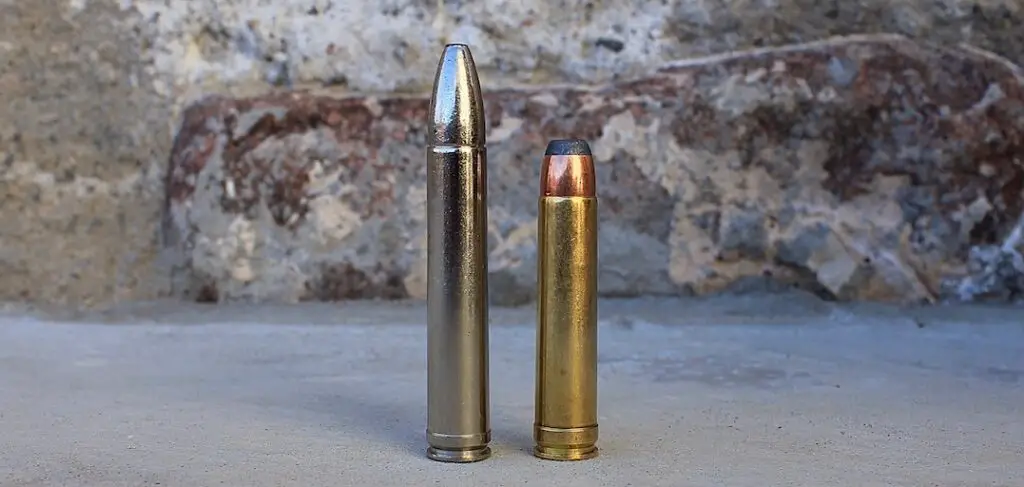
From the start, Marlin introduced a special version of their legendary Model 1895 lever-action rifle chambered in .450 Marlin and Hornady began producing ammo for the cartridge as well.
However, while Hornady and Marlin essentially achieved what they set out to accomplish with the .450 Marlin, the cartridge was not a smashing commercial success. A decent number of hunters adopted the new cartridge, but many others saw the .450 Marlin as the solution to a non-existent (or at least not very severe) problem.
The underwhelming commercial success of the .450 Marlin wasn’t due to any major shortcomings on part of the cartridge. On the contrary, and as we’ll discuss more in a minute, the .450 Marlin is a well-designed and heavy hitting round. Hornady and Marlin manufactured good quality rifles and ammo for the cartridge and it basically performed as advertised.
So what happened?
Well, let’s talk about the ballistics of the cartridge and how the .450 Marlin stacks up next to the .45-70, both of which will help explain why it didn’t take off like the folks and Hornady or Marlin hoped.
450 Marlin Ballistics
Typical .450 Marlin ballistics are a 325gr FTX bullet at 2,225 fps (3,572 ft-lbs), a 405gr JFN bullet at 1,975 fps (3,507 ft-lbs), or a 500gr FMJ-FN bullet at 1,625 fps (2,931 ft-lbs). Those loads have stout recoil, but also deliver heavy hitting, bone crushing power at short range.
As intended, the .450 Marlin is a very powerful cartridge that’s easily capable of cleanly and ethically taking just about every species of North American big game from deer and javelina all the way up to moose and Alaskan Brown Bear.
450 Marlin vs 45-70
The .450 Marlin has ballistics almost identical to magnum .45-70 Government ammunition and the cartridge fires the same weight bullet approximately 600fps faster than lower pressure .45-70 ammo intended for use in the Trapdoor Springfield. The .450 Marlin and the .45-70 Government are not interchangeable, but are very similar in overall size.
That’s how the two cartridges compare to each other in a nutshell. As we drill down into the details of their similarities and differences though, several especially important factors emerge.
First, the .450 Marlin and the .45-70 Government both fire the same .458″ diameter bullets. There is a lot of overlap in the common bullet weights they use and the two cartridges often use the exact same bullets in the 250 grain to 500 grain range.
In particular, 325 grain, 350 grain, 405 grain, and 500 grain bullets are very common with both cartridges.
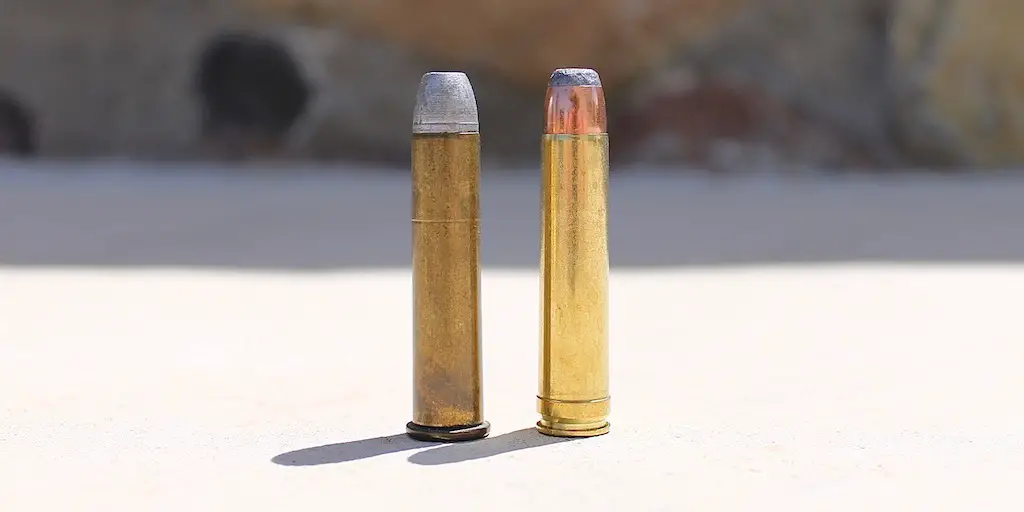
The two cartridges have the same overall length (2.55″) and very similar case lengths (2.1″ for the .450 Marlin and 2.105″ for the .45-70). For this reason, the cartridges have a similar case capacity, though the .45-70 has a slight edge in this area.
Additionally, the .45-70 uses a rimmed case while the .450 Marlin has a belted case. This prevents accidental cross-chambering of the two cartridges.
The fact that the .450 Marlin uses a belted instead of a rimmed case also means the cartridge is better suited for use in bolt action rifles than the .45-70 Government. That said, aside from the Siamese Mauser for the .45-70 and a small number of Steyr-Manlicher rifles in .450 Marlin, both cartridges are most commonly used in lever action and (to a lesser extent) single shot rifles.
Finally, the Marlin cartridge has a much higher SAAMI maximum pressure of 43,500psi vs 28,000psi for the .45-70 Government.
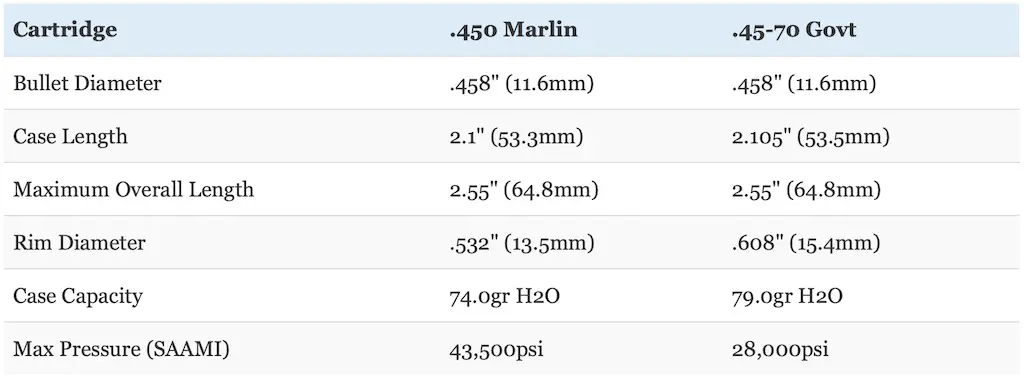
Note: while the powder capacity figures listed above do give a good indication of the differences between the two cartridges, exact case capacities vary slightly according to the brand of brass used.
The table below compares 325gr Hornady FTX (.230 BC) and Buffalo Bore 405gr Jacketed Flat Nose (.216 BC) loads for each cartridge as well as a 405gr Remington Core-Lokt (.281 BC) load that essentially duplicates the original .45-70 loading. This data is for Hornady LEVERevolution, Remington, and Buffalo Bore factory ammo using a 100 yard zero.
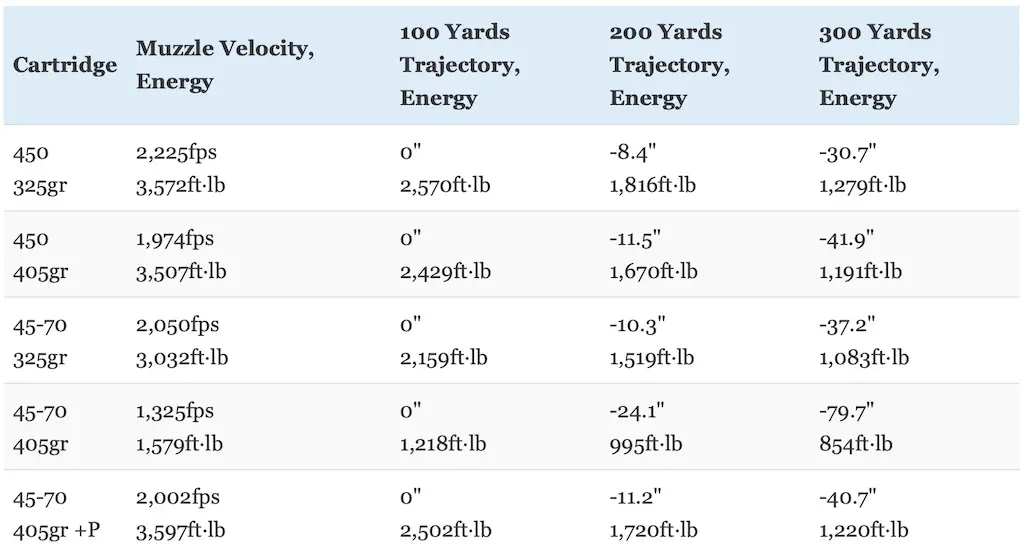
Just as you’d expect, the .450 Marlin and the magnum .45-70 loads have very similar ballistics that are considerably more powerful than the original black powder .45-70 loading. The .450 has a slight edge with the Hornady ammo, but the script flips in favor of the .45-70 with the Buffalo Bore ammo.
That shouldn’t be surprising at all, especially considering that the .450 Marlin was literally designed to mimic the performance of magnum .45-70 ammo.
Yes, some loads advertise slightly better performance for the Marlin cartridge compared to the .45-70 and vice-versa. However, the differences between them are small enough at times that it’s possible to see that much shot to shot variation within the same box of ammo for a particular cartridge. The same goes with different barrel lengths.
Bottom line: the .450 Marlin has almost identical ballistics to magnum .45-70 ammo and both are quite a bit more powerful than the lower end .45-70 Government loads safe to use in the Trapdoor Springfield.
Not surprisingly, the .450 Marlin and the .45-70 Government have almost the same amount of recoil as well.
After all, the two cartridges have almost identical ballistics and are available in many of the same rifles. They both have a pretty stout recoil, but neither has a decided advantage in this area.
So where do we stand overall with the .450 Marlin vs .45-70 Government?
Basically, the .450 has virtually the same ballistics as the hottest .45-70 Government loads and is considerably more powerful than the reduced power loads safe for use in the Trapdoor Springfield.
Neither one really excels at longer range, but both the .450 Marlin and the .45-70 deliver the bone crushing power and deep penetration necessary for hunting large, tough animals such as moose and grizzly bear at short to moderate range. They’re also well suited for hunting deer, feral hogs, black bear, and even elk at reasonable ranges.
Compared to modern high velocity cartridges like the 7mm Rem Mag or .300 Win Mag, both the .45-70 and .450 have a relatively arching trajectory. That doesn’t mean it’s impossible to shoot them at longer range, it just means doing so is very challenging.
For the most part, both cartridges are most common in short barreled lever action rifles. These rifles are often easy to carry, whether on foot or on horseback, and are quick to mount and fire. For all these reasons, the .45-70 and .450 Marlin are perfect for hunting basically every species of North American big game in thick woods or heavy cover where short range shots (>100 yards) are common.
Additionally, don’t get the impression that those reduced powered .45-70 loads for the .45-70 are too weak for hunting either. On the contrary, hunters used those old black powder loads to take untold numbers of deer, bear, moose, and even bison over the years.
Yes, the modern .45-70 loads are more powerful, but the older loads still hit pretty hard themselves.
This really brings us back to the reason the .450 Marlin didn’t quite take off like the folks and Hornady and Marlin hoped.
Basically, the .450 Marlin simply didn’t provide enough advantages for most hunters to justify making the switch.
Sure, the .450 Marlin a great cartridge, but the .45-70 Government had over a 100 year head start to make an impression with American hunters and shooters. For this reason, the .45-70 had a massive built-in advantage in terms of rifle and ammo availability as well as a reputation as a proven performer in the eyes of thousands of sportsmen.
With all that in mind, the Marlin cartridge had to overcome a lot of institutional inertia when it came to convincing hunters to make the switch.
When it came down to it, most people elected to stick with the .45-70.
And why wouldn’t they? After all, the .450 Marlin did essentially the same thing as the .45-70 with some of the higher pressure factory or handloads.
More than anything else, instead of solving a problem for hunters and shooters, it seems like the .450 Marlin was the answer to a potential liability problem gun and ammo manufacturers had with shooters using high pressure loads in rifles that simply weren’t up to the task.
450 Marlin Ammo
There aren’t many options for loaded .450 ammunition these days. At this time, Hornady and Buffalo Bore are the only companies I’m aware of that manufacture factory .450 Marlin ammo.
It’s popular enough that some of the bigger retailers in the USA do keep some .450 Marlin ammo in stock, but it’s still not the easiest stuff to find. Fortunately, you can usually find some ammunition for the cartridge online if you look hard enough.
BUY SOME EXCELLENT 450 MARLIN AMMO HERE
Additionally, the cartridge is a very good cartridge for reloaders. Reloading components for the cartridge aren’t exactly growing on trees, but you can still normally find what you need without too much difficulty.
Finally, since it uses the same .458″ bullet size that’s also used by the .45-70, .458 SOCOM, .458 Winchester Magnum, and .458 Lott (among others), reloaders have access to a good number of outstanding quality bullets suitable for use on a wide variety of game to choose from.
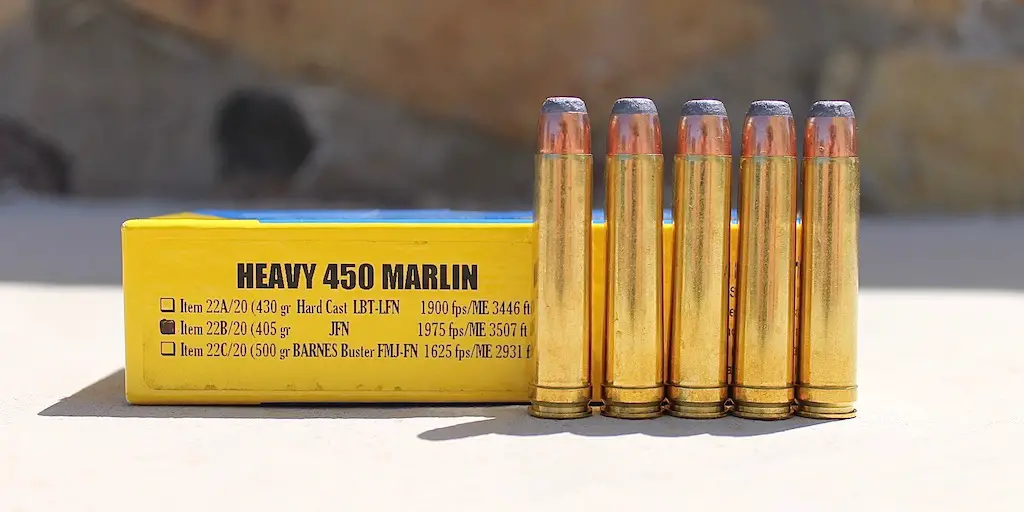
.450 Marlin Rifles
There is currently a pretty good, but not gigantic, selection of high quality rifles available for the cartridge. At this time, the Browning BLR and the Winchester Model 94 are the only two .450 Marlin rifles I’m aware of in current production.
BUY A NICE 450 MARLIN RIFLE HERE
Probably as a result of their acquisition by Remington (which had plenty of financial and legal problems itself) Marlin ceased production of the Model 1895 in .450 Marlin back in 2009. In addition to the Model 1895 most commonly associated with the cartridge, Ruger also produced their No. 1 single shot rifle in the cartridge as well, but also ceased production several years ago.
Fortunately, it’s not difficult to find examples of those rifles in good shape on the secondary market.
Best .450 Marlin Ammo For Hunting
Unfortunately, there aren’t many options for factory .450 Marlin hunting ammo right now. However, Hornady does make some very good quality ammo that really performs well for hunting a variety of big game.
Hornady’s LEVERevolution line of ammunition is specifically designed for optimum performance in lever action rifles with tubular magazines. For that reason, this ammo uses bullets with a flexible polymer tip that improve the aerodynamic characteristics of the bullet, but are still safe to use in lever guns with tubular magazines (like the Marlin 1895 Guide Gun).
Loaded with a 325 grain FTX bullet, .450 Marlin LEVERevolution ammunition has a flatter trajectory and carries more energy down range than traditional round or flat nosed .450 Marlin ammo. All in all, this is outstanding .450 Marlin ammo for hunting medium and large game like deer, black bear, feral hogs, and even moose.
- Bullet Type: Hornady FTX
- Bullet Weight: 325 grains
- Ballistic Coefficient (BC): .230 (G1)
- Muzzle Velocity: 2,225 feet per second (3,572 ft-lbs of muzzle energy)
GET 450 MARLIN LEVEREVOLUTION AMMO HERE
Final Thoughts On The 450 Marlin
While the .450 Marlin never really caught on with tremendous numbers of hunters, it’s still an excellent choice for those who need a heavy hitting cartridge for hunts in thick cover. Indeed, it’s a fantastic choice for use on North American game like deer, black bear, feral hogs, or moose at short range.
Once again, nothing in this article should be taken as a criticism of the .450 Marlin. Like I said, it’s an excellent cartridge that largely performs as advertised. If it sounds like an appealing choice for you, then get a good quality rifle, learn to shoot it accurately, and I’m sure you’ll be happy with how it performs for you afield.
Enjoy this article about the 450 Marlin? Please share it with your friends on Facebook and Twitter.
The Lyman 50th Edition (p352-362) and Hornady 10th Edition (p754-764) reloading manuals provided information for the history of .450 Marlin and the .45-70 Govt as well as data used to compare their size. The data used to compare the trajectory and recoil of the cartridges was obtained from Hornady (here and here), Buffalo Bore (here and here), and MidwayUSA. Maximum pressure for the .450 Marlin and .45-70 Govt were obtained from SAAMI (p34). KWK provided case capacity data for the .450 Marlin and the .45-70 Government. I used Shooters Calculator to compare trajectories, wind drift, and recoil for the cartridges.
Make sure you follow The Big Game Hunting Blog on Facebook, Instagram, Twitter, and YouTube.
NEXT: 30-30 vs 45-70 WHICH LEVER ACTION IS BEST FOR YOU TO HUNT WITH?
NEXT: BEST 6.5 CREEDMOOR AMMO FOR HUNTING ELK, DEER, AND OTHER BIG GAME
John McAdams is a proficient blogger, experienced shooter, and long time hunter who has pursued big game in 8 different countries on 3 separate continents. John graduated from the United States Military Academy at West Point and is a veteran of combat tours with the US Army in Iraq & Afghanistan. In addition to founding and writing for The Big Game Hunting Blog, John has written for outdoor publications like Bear Hunting Magazine, The Texas State Rifle Association newsletter, Texas Wildlife Magazine, & Wide Open Spaces. Learn more about John here, read some of John’s most popular articles, and be sure to subscribe to his show: the Big Game Hunting Podcast.


Hi, I was a 450 MARLIN user in a Winchester 94 takedown and it was great, but I had to get rid of it because of the loud bang it provided because of the muzzle ports (almost lost my left ear…) so I purchased a MARLIN SBL in 45.70.
I have to admit that the stopping power of the 45.70 325 gr FTX from HORNADY is not at all the same as the stopping power or the projectile expansion of the same 325 gr FTX in 450 MARLIN, I think that the 200 fps less in the 45.70 has something to do with it.
2 weeks ago I shot a white tail in the neck with the 45.70 325 FTX and the Bullitt went rite threw with no expansion and I found the animal dead more than 500 meters away from where I hit him, honestly if I don’t find blood I thought I missed him, the same thing happened with 2 wild boars and an elk weeks before… that never happened to me with the 450 MARLIN, all of the shots were directly terminal and all I killed with it just stayed rite there.
(So please HORNADY can you provide good hi pressure loads in 45.70 like the BUFALO BORE ammo ???)
Any way I thank you for the information I got reading you, now I know that I can reload safely my 45.70 up to 43500 psi for my MARLIN SBL.
Kind regards
F.PIQUES
(Coooooooonasssss)